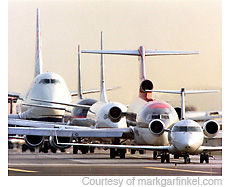 | |||||||||||||||||||
|
|
 |
|||||||||||||||||
The U.S. airline industry touches nearly every person's life. Every day, airlines transport millions of people and goods quickly and easily around the globe. As a result, the health of regional, national, and global economies is inextricably linked to this vital industry. Today, the airline industry is at a crossroads. After 35 years since deregulation – and after multiple cycles of financial successes and failures – the industry remains fragile. Recent years have seen multiple airline bankruptcies and mergers of iconic legacy carriers. Increased competitive pressure from low-cost carriers, national and global economic downturns, high and volatile fuel prices, and the transparency of pricing facilitated by the Internet and online travel distribution channels have all contributed to a challenging economic climate for the airline industry in the United States. Since 2006, fuel has emerged as the single largest industry expense, surpassing labor costs for the first time. These and other outside influences have all led to the conclusion that the airline business has been irrevocably changed, and new operating models and approaches are necessary. For instance, a wave of "capacity discipline"– a more conservative capacity management strategy that emphasizes profitability over market share – from 2009 - 2012 is one such example of a new paradigm of industry strategy. The recovery round (2002 - 2007) of labor negotiations and restructurings – many under Chapter 11 – led to significant changes in labor costs and productivity. With those changes, airline employees helped contribute to the short-term stabilization of the industry. Finding a new model for compensation that is durable and works to address the cyclicality of the industry will be critical. Just as important will be the efforts of management to identify non-labor cost savings that can be sustained as networks and operating models are reconfigured. Following restructuring, mergers, and capacity discipline, U.S. airlines in 2017 were the most profitable in recent memory. However, challenges in the industry still remain. The volatility of fuel prices continues to be a concern for U.S. carriers. The prevalence of online distribution systems have increased competition and caused carriers to bolster ancillary revenues through fees for checked bags and other services. And the terrain of the competitive landscape in the U.S. after the industry is left with just four major carriers –American, Delta, United, and Southwest– remains to be seen. Only the data in broad historical context tells the full story. The goal of the Airline Data Project is to confirm – and in some cases dispel – the conventional wisdom about the airline industry. The ADP represents a unique and comprehensive body of data that enables a better understanding of the U.S. airline industry and its operating environment - including those factors that should be considered as the industry confronts consolidation, new competition, and renegotiated labor contracts. The ADP provides a new resource for MIT students, the academic community, financial community, and the news media that we hope will be instrumental in identifying the fundamental cycles in the industry's financial performance and the factors driving those cycles. We invite you to review this data, share your thoughts on the content and make suggestions for other areas of analysis that would be beneficial in assessing the industry's financial health and prospects.
| |||||||||||||||||||
 |
|||||||||||||||||||
| Accessibility | |||||||||||||||||||
| Accessibility | |||||||||||||||||||

